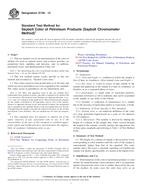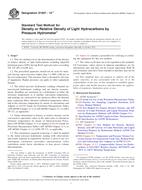We need your consent to use the individual data so that you can see information about your interests, among other things. Click "OK" to give your consent.
ASTM D4629-12
Standard Test Method for Trace Nitrogen in Liquid Petroleum Hydrocarbons by Syringe/Inlet Oxidative Combustion and Chemiluminescence Detection
STANDARD published on 15.4.2012
The information about the standard:
Designation standards: ASTM D4629-12
Note: WITHDRAWN
Publication date standards: 15.4.2012
SKU: NS-27953
The number of pages: 5
Approximate weight : 15 g (0.03 lbs)
Country: American technical standard
Category: Technical standards ASTM
The category - similar standards:
Annotation of standard text ASTM D4629-12 :
Keywords:
liquid hydrocarbons, total nitrogen, Boundary lubrication properties, Chemiluminescence detection, Combustion--petroleum products, Distillate fuels, Hydrocarbons, Naphtha and naphtha derivatives, Nitrogen content--petroleum products, Petroleum oils, Process feeds, Trace elements--petroleum products, Viscosity--petroleum products, ICS Number Code 75.080 (Petroleum products in general)
Additional information
| Significance and Use | ||||||||
|
Some process catalysts used in petroleum and chemical refining may be poisoned when even trace amounts of nitrogenous materials are contained in the feedstocks. This test method can be used to determine bound nitrogen in process feeds and may also be used to control nitrogen compounds in finished products. |
||||||||
| 1. Scope | ||||||||
|
1.1 This test method covers the determination of the trace total nitrogen naturally found in liquid hydrocarbons boiling in the range from approximately 50 to 400°C, with viscosities between approximately 0.2 and 10 cSt (mm2/s) at room temperature. This test method is applicable to naphthas, distillates, and oils containing 0.3 to 100 mg/kg total nitrogen. For liquid hydrocarbons containing more than 100 mg/kg total nitrogen, Test Method D5762 can be more appropriate. This test method has been successfully applied, during interlaboratory studies, to sample types outside the range of the scope by dilution of the sample in an appropriate solvent to bring the total nitrogen concentration and viscosity to within the range covered by the test method. However, it is the responsibility of the analyst to verify the solubility of the sample in the solvent and that direct introduction of the diluted sample by syringe into the furnace does not cause low results due to pyrolysis of the sample or solvent in the syringe needle. 1.2 The values stated in SI units are to be regarded as standard. No other units of measurement are included in this standard. 1.3 This standard does not purport to address all of the safety concerns, if any, associated with its use. It is the responsibility of the user of this standard to establish appropriate safety and health practices and determine the applicability of regulatory limitations prior to use. See 6.2, 6.4, 6.5, 6.9, and Section 7. |
||||||||
| 2. Referenced Documents | ||||||||
|
Similar standards:
Historical
1.6.2012
Historical
1.5.2013
Historical
1.12.2012
Historical
15.6.2014
Historical
1.11.2012
Historical
1.6.2012
We recommend:
Updating of laws
Do you want to be sure about the validity of used regulations?
We offer you a solution so that you could use valid and updated legislative regulations.
Would you like to get more information? Look at this page.



 ASTM D1298-12b
ASTM D1298-12b ASTM D1319-13
ASTM D1319-13 ASTM D1500-12
ASTM D1500-12 ASTM D1552-08(2014)e..
ASTM D1552-08(2014)e.. ASTM D156-12
ASTM D156-12 ASTM D1657-12e1
ASTM D1657-12e1
 Cookies
Cookies
